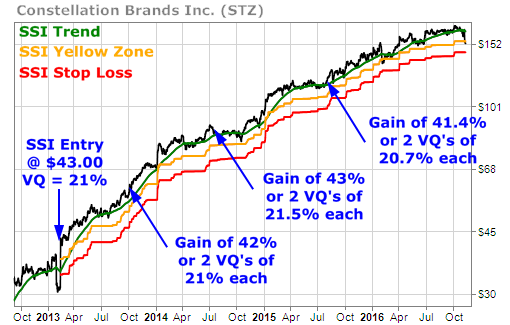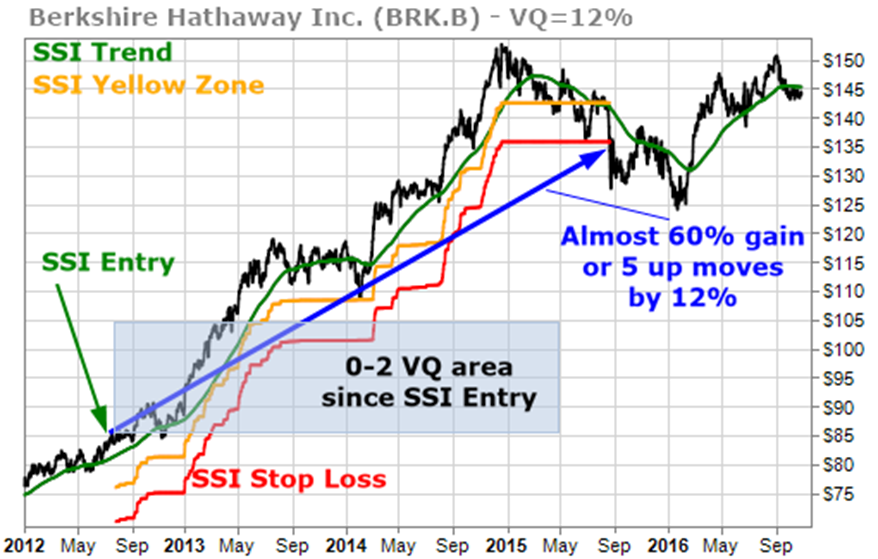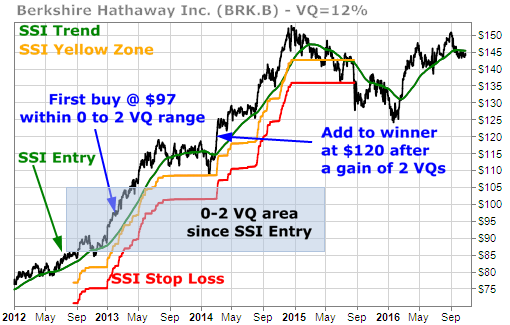What do you mean 2 VQ?
Last week’s article on doubling up on your winners seems to have struck a chord. After reading it, longtime subscriber Joe M wrote in and said,
Just so you know, as I was reading this, I said out loud, “YES!!” That reaction rarely happens….
Thanks Joe!
Joe wasn’t the only one that had something to say about our recent research. Phillip D. wrote in asking for some clarification.
Been reading TradeSmith’s recent articles with interest. One concern I have is that we are told to buy more of a rising stock that has an SSI entry signal after it has reached 2 VQ’s (and then more after another 2 VQ’s etc.). But we are also told that it’s OK to buy the stock at a price of up to 2 VQ’s following the SSI entry signal, which implies it’s not OK to buy above the 2 VQ level. Am I missing something?
Phillip is referring to a point of possible confusion from the past two Tuesday editorials that we’ve published. Let me explain.
In the article mentioned above on “doubling up on your winners,” we presented a strategy for adding to winning positions after every 2 VQs of gain. We shared an example of this strategy using Constellation Brands (STZ) and adding to this winning position at each of the blue arrows on the chart below.
The week before last, however, we had written to readers on the topic of “when is it too late to buy after an SSI Entry signal?” In that article we used the example of Berkshire Hathaway and shared that our research showed that it would have been a good bet to buy Berkshire any time before it gained more than 2 VQs from its initial SSI Entry signal.
As Phillip points out, in one article we’re saying, “Don’t buy if the stock has already gained more than 2 VQs,” and in the next article, we’re saying, “Buy more every time the stock gains another 2 VQs.”
The confusion is understandable.
First, let me say that I do want everyone to understand that the research we’ve been sharing these past few weeks is still evolving. We’re very excited about it … and it has impacted my personal investing strategies already … but there is still more research to be done before we bake this into the cake as an official TradeStops best practice.
That said, there is an explanation for the apparent contradiction that Phillip has flagged. In the example of Berkshire Hathaway, we are only referring to the initial position in the stock. If a stock triggers an SSI Entry signal, our research shows that it’s best to establish an initial position before the stock has gained 2 VQs. (In the case of Berkshire, the VQ was 12% so that means buy before it has gained 24% from its entry signal.)
If, however, you have established an initial position within 2 VQs of the initial entry signal, our research further suggests that if you add to the winning position after each successive 2 VQs of gains, you have a great chance of making more money than you would if you don’t add to such winning positions.
Let’s look at how this might work using our example of Berkshire Hathaway again.
Berkshire first triggered an SSI entry signal in mid-2012 at around $85. At the time it had a VQ of 12%. According to our first research piece, it would have been safe to buy Berkshire up to $105.40 (24% above $85).
An investor could have purchased Berkshire 6 months later in early 2013 at $97 and still been confident of profits. Should our investor have decided to follow the suggestions of our “doubling up” research, then s/he would be looking to add to this winner after another 24% gain from the $97 entry price … at about $120.
I hope that clears up any confusion, Phillip.
Subscriber Joe M., who I mentioned at the top of this article, referred to this “add to winners” strategy as “watering the flowers.” I love that idea. Our trailing stop strategies help us to pull the weeds from our portfolio, and this strategy of adding to winners is like watering the flowers that remain.
Great metaphor, Joe!
I hope that everyone enjoys a rest-filled holiday. We all deserve it after surviving the markets of 2016.
To watering the flowers,
TradeSmith Research Team